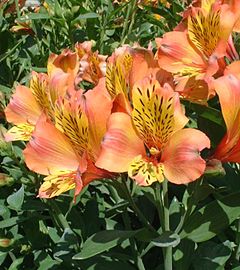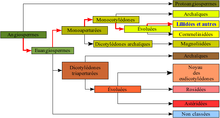Alstroemeriaceae
Les Alstroemeriaceae (Alstroémériacées ou Alstrœmériacées), créée par la classification phylogénétique APG III regroupe des plantes monocotylédones qui comprend environ 200 espèces réparties en 4 à 5 genres. Ce sont des plantes herbacées, vivaces, rhizomateuses ou à bulbe, parfois grimpantes, des régions tempérées à tropicales d'Amérique centrale et d'Amérique du Sud.

Voir le texte pour plus d'information.
| Clade | Angiospermes |
|---|---|
| Clade | Monocotylédones |
| Ordre | Liliales |
En classification classique ces plantes faisaient partie des Liliacées.
Étymologie
modifierLe nom vient du genre Alstroemeria donné en hommage au Baron Clas Alströmer (1736-1794) naturaliste suédois élève et ami de Linné (1707-1778)[1].
Classification
modifierEn classification classique de Cronquist (1981)[2] la famille n'existe pas et ces plantes sont assignées aux Liliacées.
Liste des genres
modifierLa classification phylogénétique APG III (2009)[3] inclut dans cette famille les genres précédemment placés dans la famille Luzuriagaceae. Les genres Drymophila, Luzuriaga pour être précis.
Selon World Checklist of Selected Plant Families (WCSP) (15 avr. 2010)[4] :
- Alstroemeria L. (1762)
- Bomarea Mirb. (1804)
- Drymophila R.Br. (1810) (anciennement dans la famille Luzuriagaceae)
- Schickendantziella Speg. (1903)
Selon Angiosperm Phylogeny Website (20 mai 2010)[5] :
- Alstroemeria L.
- Bomarea Mirb.
- Leontochir Phil.
- Schickendantzia Pax
Selon NCBI (15 avr. 2010)[6] (Plus conforme à APGIII puisqu'il incorpore les genres Drymophila, Luzuriaga anciennement dans Luzuriagaceae) :
- Alstroemeria
- Bomarea
- Drymophila (anciennement dans la famille Luzuriagaceae)
- Leontochir
- Luzuriaga (anciennement dans la famille Luzuriagaceae)
Selon DELTA Angio (15 avr. 2010)[7] :
Notes et références
modifier- ↑ (en) Maarten J M Christenhusz, Michael F Fay et Mark W. Chase, Plants of the World : An Illustrated Encyclopedia of Vascular Plants, Chicago, The University of Chicago Press, , 816 p. (ISBN 978-0-2265-2292-0, lire en ligne), p. 145
- ↑ (en) Arthur Cronquist, An Integrated System of Classification of Flowering Plants, New York, CUP, (ISBN 0-231-03880-1, OCLC 1136076363, lire en ligne).
- ↑ (en) Angiosperm Phylogeny Group, « An update of the Angiosperm Phylogeny Group classification for the orders and families of flowering plants: APG III », Botanical Journal of the Linnean Society, Wiley-Blackwell, Linnean Society of London et OUP, vol. 161, no 2, , p. 105–121 (ISSN 0024-4074 et 1095-8339, DOI 10.1111/J.1095-8339.2009.00996.X).
- ↑ WCSP. World Checklist of Selected Plant Families. Facilitated by the Royal Botanic Gardens, Kew. Published on the Internet ; http://wcsp.science.kew.org/, consulté le 15 avr. 2010
- ↑ Stevens, P. F. (2001 onwards). Angiosperm Phylogeny Website. Version 14, July 2017 [and more or less continuously updated since]." will do. http://www.mobot.org/MOBOT/research/APweb/, consulté le 20 mai 2010
- ↑ NCBI, consulté le 15 avr. 2010
- ↑ DELTA Angio, consulté le 15 avr. 2010
Liens externes
modifier- (en) World Checklist of Selected Plant Families (WCSP) : Alstroemeriaceae
- (en) Angiosperm Phylogeny Website : Alstroemeriaceae ()
- (en) DELTA Angio : Alstroemeriaceae Dum.
- Voir aussi Liliaceae
- (en) Tree of Life Web Project : Alstroemeriaceae
- (fr) Tela Botanica (France métro) : Alstroemeriaceae
- (en) Paleobiology Database : Alstroemeriaceae Dumortier
- (fr + en) ITIS : Alstroemeriaceae Non valide
- (fr + en) ITIS : Liliaceae
- (en) NCBI : Alstroemeriaceae (taxons inclus)
- (en) GRIN : famille Alstroemeriaceae Dumort. (+liste des genres contenant des synonymes)
- (en) Catalogue of Life : Alstroemeriaceae (consulté le )
- (en) NCBI : Alstroemeriaceae (taxons inclus)
- (en) UICN : taxon Alstroemeriaceae (consulté le )
- (en) GRIN : famille Alstroemeriaceae Dumort. (+liste des genres contenant des synonymes)

